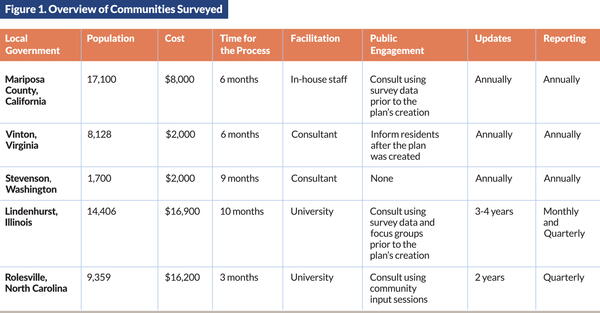
Strategic plans can be valuable tools that guide managers and their governing bodies in making complex decisions and navigating challenging periods. And yet, financial constraints, limited staff capacity, and lack of buy-in from elected officials are just a few examples of the numerous challenges to strategic planning faced by managers of small local governments.
Despite knowing that a strategic plan is helpful, in reality, small communities often struggle to create and implement one. In a recent survey I conducted of 90 communities under 20,000 in population, only about 50 percent of the officials responding indicated they have a completed strategic plan.1 The remaining communities had only some components or a plan in process (29 percent) or no plan at all (21 percent).
I have found through my years of work with small communities that strategic planning does not have to be complicated. Even a simple plan is better than no plan, and managers have found ways to tailor planning processes to fit their community’s constraints and needs. As small local governments receive historic amounts of federal aid with the passage of the American Rescue Plan Act (ARPA), now more than ever, strategic plans can be a useful tool when determining how to allocate these once-in-a-lifetime funds to maximize their long-term benefit to our communities.
Organizational Capacity Challenges and How to Address Them
Small communities, in general, have a lack of organizational capacity for strategic planning initiatives. Organizational capacity is comprised of financial capacity, administrative capacity, and leadership capacity.
Over the last several months, I have partnered with ICMA to conduct research on the unique aspects of strategic planning for smaller communities, including a survey and case studies from local government organizations under 20,000 in population. As seen in Figure 1, each local government approached strategic planning in a unique way to best suit their community’s needs.

To get started developing a strategic plan, these organizations had to tackle the three organizational capacity issues common among small local governments.
Financial Capacity
The first major barrier is the lack of financial capacity for discretionary funding initiatives. Sixty-four percent of local governments responding to the survey reported that they do not have the funding available for a strategic planning process. In my experience with small communities in a challenging area of the country, the ability to prioritize resources is essential because of the lack of resources.
The city of Stevenson, Washington, saw the value in strategic planning when faced with a slew of competing, important, and high-cost projects. With $16 million in mandated sewer updates, a need for a new fire hall, and numerous complicated street improvements, they needed a way to prioritize and plan for these upcoming expenses straining their already-limited budget. Stevenson hired a facilitator for $2,000 to conduct a retreat over the course of a day and a half. City staff and elected officials updated, created, and prioritized goals for the organization that resulted in a five-year strategic plan with a vision, mission, and SMART (Specific, Measurable, Achievable, Relevant, and Time-Bound) goals. To capitalize on the cost of creating the strategic plan, they review it annually and use it as a tool to create the budget for the following year.
While some of the communities listed spent up to $17,000 creating their plan, Stevenson made it work for them with a small investment that created a tool to help navigate competing projects and allocate funds strategically.
“The mayor was on-board to begin with and recent events at the city created the impetus for council to change direction and look at a better way to plan for the future,” reported Leana Kinley, city administrator of Stevenson, Washington.
Administrative Capacity
In small communities, it is especially common that staff “wear many hats” and are responsible for a wide variety of services and programs. For many small communities, the lack of administrative capacity, in terms of number of staff and capabilities of staff, is the second major barrier to strategic planning. Of the communities surveyed, 44 percent of local governments agreed they do not have the time to do a strategic plan and 41 percent agreed they do not have the staff expertise to do a strategic plan.
But small communities do not have to “reinvent the wheel.” Mariposa County used existing information from their economic vitality strategy and a community survey to inform their strategic plan. Your capital improvement plan and annual budget can be useful tools when creating visioning and planning statements for a strategic plan and these documents should be aligned and work together. Look to your state associations, ICMA, and nearby communities for existing processes, materials, and resources that you can adapt to fit your own community.
To ease the administrative burden on staff, almost 60 percent of responding governments used an outside facilitator. Mariposa County hired a facilitator to help when establishing a new strategic plan and noted that finding the right facilitator was key. They plan to work with one again when it comes time for a larger update. For the town of Rolesville, North Carolina, a facilitator was hired to create their first strategic plan, but internal staff were responsible for the scheduled two-year update.
Finally, it is worth restating that a simple plan is better than no plan. Whether you conduct a formal or informal process with a facilitator, do what makes the most sense for your community. Mariposa County, California, recommends erring on the side of simplicity: “We’ve debated back and forth between a thorough plan with estimated budgets, specific performance targets and timelines, and a simpler conceptual plan. For our first time, we opted for simple and now think we should make it even more simple. One page would be ideal to make it a frequent reference that is easy to remember and use,” said Dallin Kimble, county administrative officer of Mariposa County, California.
Leadership Capacity
The last major barrier for small communities is the lack of elected official support for strategic planning. Overall, 38 percent of local governments agreed that elected officials are not interested in developing a strategic plan. As one survey respondent stated, “Our biggest challenges are engaging elected officials in prioritization and strategic planning efforts. (A lot of this depends on the mix of your board or council at any point in time.)”
Elected officials can be resistant to developing a strategic plan for a variety of reasons, such as a fear of losing control or a lack of understanding the purpose. Even before beginning a strategic planning process, it is essential to gain the elected officials’ approval. Take time to outline the benefits of creating a plan with your elected officials, explaining that a strategic plan can:
- Serve as a communication device for elected officials, staff, and the public.
- Help prioritize organizational work and the limited financial resources available.
- Serve as a decision-making tool for controversial issues.
- Create clear guidance on the goals of the governing body to the manager and can serve as an accountability tool for their performance.
Dallin Kimble of Mariposa County remarked, “We’re fond of saying that we don’t want buy-in, we want ownership. Our elected officials had ownership in the strategic plan because they directed staff to put it together and were involved in the process.”
If the terminology of a strategic plan is making your elected officials wary, try giving it a different name or integrating the components into existing structures like the annual budget. As one survey respondent shared, their “board is wary of a single strategic plan, but have essentially participated in developing a group of plans that together provide a strategic vision.”
Once the town of Rolesville, North Carolina, had created their strategic plan, they focused on regular communication to keep the plan alive and relevant. They created 11” x 17” copies of the plan and placed them in front of the elected officials at all board meetings, hung them on staff bulletin boards, and included copies in their new hire onboarding packets. According to Town Administrator Kelly Arnold, “These easy-to-find copies of the plan help ensure it remains accessible to all and relevant to decision-making.”
Conclusion
Ultimately, the key to successful strategic planning in a small community is to tailor the process to fit your needs. For more information on this research, keep an eye out for the final report, “Strategic Planning for Small Communities,” for an in-depth exploration of these challenges as well as practitioner-oriented recommendations.
This research is part of ICMA’s Local Government Research Fellowship program. ICMA Research Fellows are practitioners and academics that conduct action-oriented research addressing important trends, drivers, and issues facing local governments. Their work advances ICMA’s strategic priority to provide thought leadership and resources that support members and other local government stakeholders in creating and sustaining thriving communities throughout the world.

STEPHANIE D. DAVIS, PhD, is a collegiate assistant professor at Virginia Tech and the program director for the graduate certificate in local government management. Prior to her position with Virginia Tech, Davis served in local government for 20 years as a budget and management analyst; finance, human resources, and information technology director; and vice president/consultant for a national consulting firm.
Endnote
1 The survey was distributed electronically in August 2021 by the Virginia Municipal League, Virginia Association of Counties, Virginia Local Government Management Association, and ICMA, with responses received from local government officials in 24 states. Data analysis was conducted during the month of September 2021. Full results will be available in the forthcoming ICMA publication, “Strategic Planning for Small Communities.”
New, Reduced Membership Dues
A new, reduced dues rate is available for CAOs/ACAOs, along with additional discounts for those in smaller communities, has been implemented. Learn more and be sure to join or renew today!
